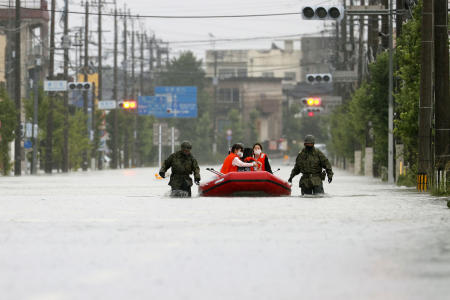
- ARAB NEWS
- 05 Jul 2025

TOKYO: Floodwaters from a swollen river amid torrential rains in Japan’s Kyushu southwestern region have reached as high as 4.3 meters in the city center of Hitoyoshi, Kumamoto Prefecture, a survey revealed Wednesday.
This was “one of the worst flood damage,” Kumamoto University associate professor Kei Ishida said. In the city of Hitoyoshi, 18 people died in disasters caused by the downpours.
According to the university’s Center for Water Cycle, Marine Environment and Disaster Management, which conducted the survey, the maximum inundation height was confirmed at a point on the right bank of the Kuma River, close to its confluence with a tributary.
A utility pole near a shrine located close to the point has flood marks, showing that floodwaters reached a height of 2.1 meters in 1965 and 1.1 meters in 1971. The latest flooding was more than double the height in 1965, reaching the second floor of a house.
The seasonal rain front that caused downpours in Kyushu since the weekend brought heavy rains to wide areas in western and eastern Japan on Wednesday morning. A total of 58 deaths have been confirmed due to the heavy rains, while 16 people, including 10 in Kumamoto and one each in the city of Minamisatsuma in Kagoshima Prefecture and the city of Hita in Oita Prefecture, both in Kyushu, are unaccounted for.
Self-Defense Forces members and others have been engaged in search and rescue operations in disaster-hit areas.
A car carrying four people and another vehicle were spotted being washed away by floodwaters in the city of Yufu in Oita.
In Fukuoka Prefecture, also in Kyushu, about 4,000 houses, mainly in southern areas such as the city of Omuta, were flooded. Recovery efforts have been hindered by floodwaters in the city of Kurume.
The water levels of five rivers in Japan exceeded the points signaling the risk of flooding as of noon Wednesday (3 a.m. GMT), according to the land ministry. They are the Yamanoi River in Fukuoka, the Ane River in Shiga Prefecture, western Japan, the Kiso River in the central prefectures of Nagano and Gifu, the Sai River in Nagano, and the Bijo River in Miyagi Prefecture, northeastern Japan.
A total of 123 landslides have been reported in 18 prefectures, mainly in Kyushu and the Shikoku western region, the ministry said.
Damage, such as bridges being washed away, has been confirmed at the Hisatsu Line and the Kyudai Main Line of Kyushu Railway Co., or JR Kyushu, and the Yunomae Line of Kumagawa Railway in Kyushu.
Bullet train services were reduced on the section between Kumamoto and Kagoshima-Chuo stations of JR Kyushu’s Kyushu Shinkansen Line. Train operations were suspended on some sections of the company’s Kagoshima Main Line and the Nippo Main Line.
At a meeting Wednesday of the Japanese government’s headquarters in response to the rain disasters, Prime Minister Shinzo Abe instructed relevant ministers to “make all-out efforts” to rescue people stranded in the disasters while speeding up the transportation of personnel and goods to affected areas, pointing out that some areas in not only Kyushu but Gifu and Nagano have been isolated.
He also called on the ministers to continue working hard to search for missing people in cooperation with local governments concerned.
The prime minister asked citizens across the nation to maintain maximum alert, citing the possibility of heavy rains hitting wide areas on Thursday.
Providing livelihood support to affected people will become more important because a prolonged evacuation is likely, Abe said, urging government staff to secure housing for them, among other measures.
To help rebuild houses damaged in the disasters, it is necessary to issue victim certificates promptly, Abe said. The state will assist local government’s surveys on the extent of damage to speed up the issuance of victim certificates, he added.
JIJI Press